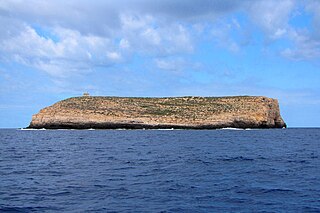
The Hyphomicrobiales are an order of Gram-negative Alphaproteobacteria.

Lampione is a small rocky island located in the Mediterranean Sea, which belongs geographically to the Pelagie Islands and administratively to the comune of Lampedusa e Linosa, Province of Agrigento, region of Sicily, Italy. It is about 200 metres long and 180 metres across, and has an area of 4 hectares and a highest elevation of 36 metres.

Campylobacterota are a phylum of bacteria. All species of this phylum are Gram-negative.
The Gemmatimonadota are a phylum of bacteria established in 2003. The phylum contains two classes Gemmatimonadetes and Longimicrobia.

The Mediterranean moray is a fish of the moray eel family. It has a long eel-like body and is found in the eastern Atlantic Ocean and Mediterranean Sea. Its bite can be dangerous to humans.

Lac de Melu is a lake in Corsica, France. At an elevation of 1,710 metres (5,610 ft), its surface area is 0.065 square kilometres (0.025 sq mi). The lake is the source of the Restonica River.
The Selenomonadales are an order of bacteria within the class Negativicutes; unlike most other members of Bacillota, they are Gram-negative. The phylogeny of this order was initially determined by 16S rRNA comparisons. More recently, molecular markers in the form of conserved signature indels (CSIs) have been found specific for all Selenomonadales species. On the basis of these markers, the Selenomonadales are inclusive of two distinct families, and are no longer the sole order within the Negativicutes. Several CSIs have also been found specific for both families, Sporomusaceae and Selenomonadceae. Samples of bacterial strains within this order have been isolated from the root canals of healthy human teeth.
Polynucleobacter is a genus of bacteria, originally established by Heckmann and Schmidt (1987) to exclusively harbor obligate endosymbionts of ciliates belonging to the genus Euplotes.
The Nautiliaceae are a family of bacteria placed in an order to itself, Nautiliales, or in the order Campylobacterales. The members of the family are all thermophilic. They are:
Acinetobacter boissieri is a gram-negative, oxidase-negative, catalase-positive, strictly aerobic nonmotile bacterium from the genus Acinetobacter which was isolated from plants' floral nectar pollinated by wild Mediterranean insects. Acinetobacter boissieri is named after botanist Pierre Edmond Boissier.
Roseivivax halotolerans is a species of bacteria. It is aerobic and bacteriochlorophyll-containing, first isolated from the epiphytes on the stromatolites of a saline lake located on the west coast of Australia. It is chemoheterotrophic, Gram-negative, motile, rod-shaped and with subpolar flagella. Its type strain is OCh 210T.
Streptomyces axinellae is a bacterium species from the genus of Streptomyces which has been isolated from the sponge Axinella polypoides in Banyuls-sur-Mer in France. Streptomyces axinellae produces axinelline A and tetromycin B.
Qipengyuania citrea is a Gram-negative, strictly aerobic, rod-shaped and non-motile bacteria from the genus Qipengyuania which has been isolated from the Bay of Calvi from the Mediterranean Sea near Corsica.
Thalassotalea is an aerobic and chemo-organo-heterotrophic genus of bacteria from the family Colwelliaceae which occur in the ocean and in sea ice.
Roseovarius albus is a Gram-negative, aerobic and heterotrophic bacterium from the genus of Roseovarius which has been isolated from seawater from the Mediterranean Sea from Spain.
Aestuariicella is a rod-shaped, Gram-negative, and strictly aerobic genus of bacteria from the order Alteromonadales with one known species. Aestuariicella hydrocarbonica was first isolated in 2015 from oil spill contaminated tidal flat sediments from the Dangjin bay in Korea. Due to the recent nature of its discovery, its taxonomic classification has not yet been accepted. Future research into its evolutionary history and genome may change the naming of this organism.
Pseudorhizobium is a genus of bacteria from the family Rhizobiaceae.
The Temperatibacteraceae are a family of bacteria.
Aureivirga is a Gram-negative, aerobic and non-motile genus of bacteria from the family of Flavobacteriaceae with one known species. Aureivirga marina has been isolated from the sponge Axinella verrucosa from the coast near Sdot Yam.
Saonia is a Gram-negative, aerobic and rod-shaped genus of bacteria from the family of Flavobacteriaceae with one known species. Saonia flava has been isolated from coastal seawater from the north-western Mediterranean Sea,




